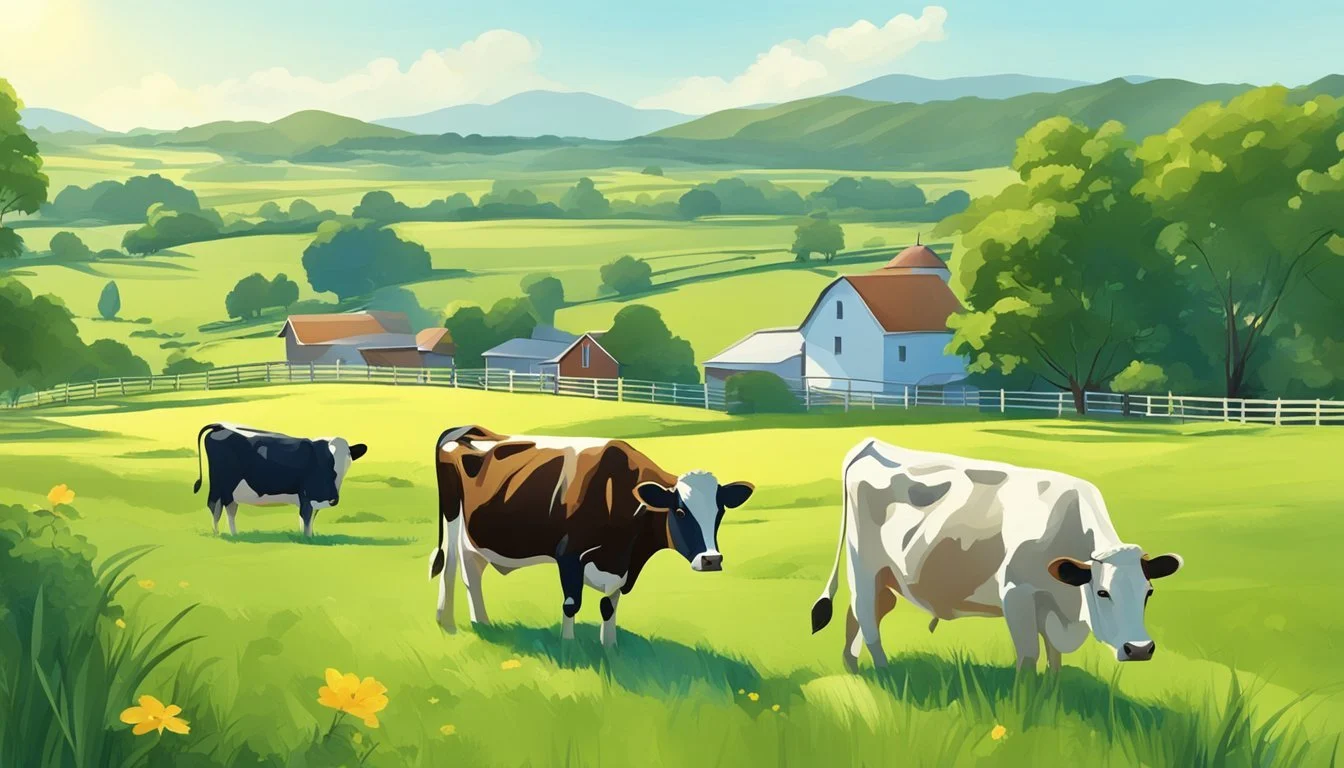Pasture Raised Yogurt
Unveiling the Health and Environmental Benefits
With growing interest in the origin and production of food, consumers are increasingly turning their attention to products like pasture-raised yogurt. This variety of yogurt is made from milk obtained from cows that graze on grass in pastures, as opposed to being primarily grain-fed in confined spaces. The practice of raising cows on pasture boasts benefits that extend to the nutritional quality of the milk, animal wellbeing, and environmental sustainability.
Grass-fed cows produce milk that reflects the seasonal variations of the grasses they consume, which can imbue the milk—and consequently the yogurt—with a fuller flavor profile and potentially varying fat contents throughout the year. As a result, it typically has a distinctive taste and texture that can set it apart from conventional yogurts.
Moreover, yogurt made from pasture-raised cows is often complemented with live and active cultures, enhancing its probiotic content. These probiotics are beneficial to gut health, and consumers seeking such health benefits may prefer the pasture-raised version for its natural production process. Organic certification, further assures consumers of the absence of synthetic pesticides and fertilizers in the yogurt's production.
What is Pasture Raised Yogurt?
Pasture raised yogurt is a dairy product made from the pasture raised milk of cows that are primarily grazed on pasture. Unlike conventional yogurt, which may be made from milk produced by cows confined to feedlots, pasture raised cows enjoy open fields and natural grass diets.
When purchasing yogurt, labels such as "100% grass-fed" or "certified regenerative" can inform customers about the farming practices used and the welfare of the cows.
Benefits of Grass-Fed Milk Yogurt
Pasture-raised yogurt is often heralded for its superior nutritional profile and commitment to sustainable farming practices.
Consumers value the potential additional health benefits of grass-fed milk products, including a higher content of certain vitamins and minerals, as well as its organic quality. These factors contribute to grass fed yogurt being perceived as made from high quality ingredients.
Nutritional Value
Typically yogurt made from pastured dairy cows contains naturally higher levels of omega-3 fatty acids and conjugated linoleic acid (CLA) due to the grass-fed diet of the cattle. Here's a snapshot of its nutrient density:
Protein: Offers a considerable amount of protein, essential for muscle repair and growth.
Calcium: Known for its high calcium content, necessary for healthy bones and teeth.
Vitamin D: Often higher in Vitamin D, supporting immunity and bone health.
Iron & Potassium: Contains iron necessary for blood health and potassium for muscle and nerve function.
By being pasture-raised, the yogurt not only provides a rich profile of nutrients but also often contains a more favorable ratio of these nutrients compared to conventionally raised counterparts. For instance, data suggests increased levels of Vitamin D and calcium, both meeting a significant portion of the daily value.
Organic Quality
Pastured yogurt usually aligns with USDA organic standards, indicating that the dairy cows have access to organic pastures and the absence of synthetic fertilizers and pesticides in their feed, leading to the term "more organic goodness."
No Synthetic Hormones: They do not receive hormones or antibiotics.
Organic Feed: The cows' diet consists of organic feed, free from GMOs.
This underscores the product's commitment to an organic lifecycle, from the pastures where the cows graze to the final yogurt product.
Environmental Impact
The environmental footprint is generally considered to be lower than that of conventional yogurt.
Sustainable Farming Practices: These farms often use rotational grazing, which can help maintain soil health and reduce erosion.
Reduced Chemical Use: Lower reliance on synthetic fertilizers and pesticides benefits the surrounding ecosystem.
Overall, this type of yogurt supports farming methods that can be more beneficial for the environment, contributing to the preservation of biodiversity and promoting a healthier planet.
Types of Yogurt
The landscape of pasture raised yogurt includes options like Greek and plain varieties, each with the potential to be flavored or unflavored. The content of live active cultures along with variations in milkfat are key differentiators in what consumers can expect from each type.
Greek vs. Plain Milk Yogurt
Greek Yogurt: Traditionally known for its thick texture and high protein content, Greek yogurt is made by straining out the whey from regular yogurt. This process creates a yogurt that is higher in protein—one serving can contain between 15 to 20 grams. Whole milk Greek yogurt, made from pasture-raised cows, also includes a more robust fat profile which can range seasonally.
Plain Yogurt: In contrast, plain yogurt is generally not as thick as Greek yogurt. It's unstrained, thereby retaining more whey which results in a creamier, more fluid consistency. Whole milk is often used for plain yogurt as well, providing a rich flavor. Protein content in plain yogurt is lower than Greek, usually around 5 to 10 grams per serving. Plain yogurt can serve as a more neutral base for adding fresh fruits and granola (how long does granola last?).
Flavored and Unflavored Varieties
Flavored Yogurt: Many pasture raised yogurts come in flavored varieties, incorporating natural ingredients such as fruits or vanilla. These yogurts can contain added sugars to enhance taste, so it is important for consumers to read labels if they are monitoring sugar (how long does sugar last?) intake.
Unflavored Yogurt: Unflavored or plain yogurts are often free from added sugars and artificial flavorings, making them a preferred choice for health-conscious consumers. They can be sweetened naturally with honey or maple syrup (how long does maple syrup last?) or used in savory dishes. These varieties may include pectin (how long does pectin last?) to improve texture, though typically in lesser amounts than found in flavored varieties.
Artificially sweetened yogurt is sometimes masquerading as healthier than it is, it is often best t go with an organic cane sugar yogurt.
Each type of pasture raised yogurt offers a distinct combination of taste, texture, and nutritional benefits, catering to diverse consumer needs and preferences.
Purchasing Guide
When buying pasture-raised yogurt, consumers should seek out reputable sources and identify the highest quality products.
Where to Buy
Buyers can find pasture-raised yogurt at health food stores, farmer's markets, and in the organic section of most grocery stores. It is also available for purchase online, where consumers can often explore more products and potentially utilize coupons for discounts.
Health Food Stores: Stores specializing in organic and natural products typically carry a range of pasture-raised yogurts.
Farmer's Markets: Local farmers often sell fresh and directly to consumers.
Grocery Stores: Look in the organic or dairy section, though selection may vary.
Online Retailers: Websites offer the convenience of home delivery and a broader selection.
Always check the expiration date and store yogurt properly, usually refrigerated, to maintain its safety and probiotic potential.
About Yogurt Production
Yogurt production begins with the selection of quality milk, primarily from cows, although goat, sheep, and buffalo milk are also used. The milk is then pasteurized to eliminate pathogens and ensure safety for consumption. During pasteurization, the milk is heated to a specific temperature for a calculated period before it is cooled. This process also denatures the proteins, making them more conducive to yogurt's texture.
The milk is homogenized to disperse the fat evenly, resulting in a consistent product. It's at this stage that additional milk powder might be added to increase the solids content, contributing to a thicker yogurt.
Key Ingredients & Enzymes:
Milk (whole, low-fat, or skim based on the desired fat content)
Live active cultures (specifically Lactobacillus bulgaricus and Streptococcus thermophilus)
Potentially additional milk powder
Next, the milk is inoculated with live yogurt cultures, the bacteria that ferment the lactose in the milk into lactic acid. This lactic acid acts on the milk protein to give yogurt its texture and tang. During fermentation, the temperature is carefully controlled to optimize the activity of the yogurt cultures.
Fermentation Time: 4 to 7 hours (variable)
Fermentation Temperature: 110-115°F (approximate)
In some manufacturing processes, an enzyme such as rennet may be added to aid in the firming of the yogurt. Once the desired flavor and consistency are reached, the yogurt is cooled to halt the fermentation process. It can then be flavored or have organic cane sugar, honey, or fruit added before packaging.
This precise control of pasteurization, homogenization, inoculation, and fermentation defines the quality of the final yogurt product.




